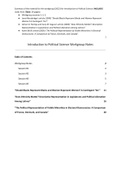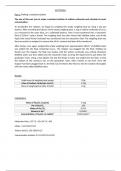Class notes
Introduction to Political Science Workgroup Notes - GRADE 8,2
- Course
- Institution
Summary of the material for the workgroup (2022) for Introduction to Political Science. INCLUDES notes from (Total: 29 pages): Workgroup sessions 1-3, 5. Jane Mansbridge’s article (1999) “Should Blacks Represent Blacks and Women Represent Women? A Contingent ‘Yes’”. Adrian D. Pan...
[Show more]





